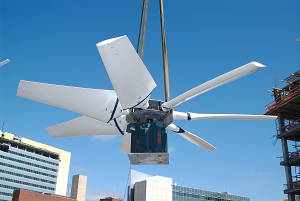PM direct-drive replaces HVAC fan gearboxes
Baldor has developed a direct-drive technology for controlling cooling tower fans in commercial buildings which, it claims, will improve reliability by eliminating moving parts, while saving energy and cutting noise levels. The technology is based on a novel high-torque PM (permanent magnet) motor that is small enough to be retrofitted into the space below a fan usually occupied by the gearbox.

The usual technique for driving cooling tower fans is to connect a standard AC induction motor via a drive shaft and disc coupling into a right-angle gearbox that reduces the motor speed to the range required by the fan. But this arrangement has drawbacks: the gearbox runs at high speed and needs regular inspection and maintenance; misalignments in the power transmission system can cause vibration, wear and noise; and the power transmission system introduces significant energy losses.
Baldor`s new VS1 cooling tower drive provides a direct, slow-speed drive for the fans, combined with variable speed control that is optimised for building cooling. Eliminating the drive shaft and gearbox minimises moving parts, improves reliability and efficiency, and cuts system costs.
Extra energy savings come from being able to operate the fan at reduced speeds during non-peak load conditions. The direct drive also reduces noise levels and eliminates the problem of cooling tower water being contaminated by leaks from gearboxes.
The motor is controlled by a drive using a specially developed algorithm which provides sensorless control of the PM motor, optimised to manage the large inertia of the fan and to reduce the starting current. The synchronous motor provides constant torque continuously from zero up to base speed.
To protect the motor in its humid operating environment, the stator windings are impregnated with epoxy, while the drive end is protected by a non-contacting, non-wearing, metallic labyrinth shaft seal.
Before it was launched, the fan drive was compared with a conventional cooling tower fan drive system in a building with two identical cooling towers housing 5.5m fans. Measurements showed a decrease in input power of about 13% for the direct-drive arrangement when running at full load.
The drive system is available in nominal power ratings from 7–145kW, 150–500 rpm base speed, to drive cooling fans with diameters from 2.1–5.5m.





